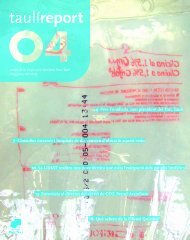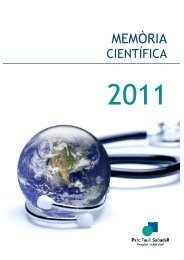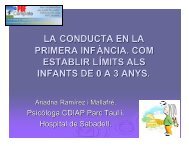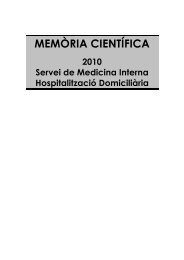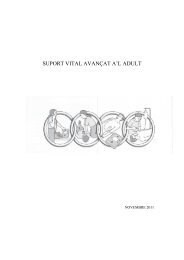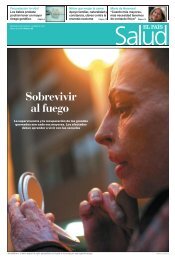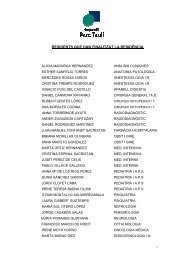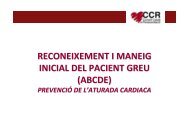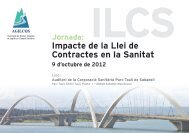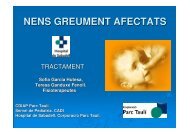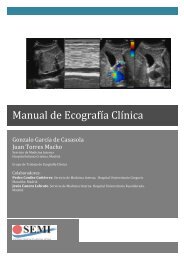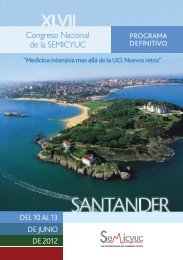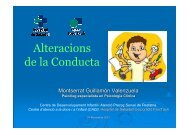- Page 1 and 2:
Manual de Urgencias de Pediatría H
- Page 3 and 4:
Cualquier forma de reproducción, d
- Page 5 and 6:
Llorente de la Fuente, Ana López D
- Page 7 and 8:
Las enfermedades que requieren “C
- Page 9 and 10:
consultas infantiles. Queremos agra
- Page 11 and 12:
Con la publicación de este libro,
- Page 13 and 14:
2.11 Síncope . . . . . . . . . . .
- Page 15 and 16:
8.7 Pancreatitis aguda . . . . . .
- Page 17 and 18:
12. Nefrología 12.1 Infección uri
- Page 20 and 21:
1.1 Reanimación cardiopulmonar G.
- Page 22 and 23:
Reanimación cardiopulmonar 3 Cuand
- Page 24 and 25:
Reanimación cardiopulmonar 5 TABLA
- Page 26 and 27:
Reanimación cardiopulmonar 7 - Se
- Page 28 and 29:
Reanimación cardiopulmonar 9 Si, d
- Page 30 and 31:
Reanimación cardiopulmonar 11 BIBL
- Page 32 and 33:
Atención inicial al politraumatiza
- Page 34 and 35:
Atención inicial al politraumatiza
- Page 36 and 37:
Atención inicial al politraumatiza
- Page 38 and 39:
Shock 19 ETIOLOGÍA. TIPOS DE SHOCK
- Page 40 and 41:
Shock 21 • Antecedentes de cardio
- Page 42 and 43:
Shock 23 Shock anafiláctico • Ad
- Page 44 and 45:
Shock 25 O min Identificar y tratar
- Page 46 and 47:
Manejo de la vía aérea 27 TABLA I
- Page 48 and 49:
Manejo de la vía aérea 29 FIGURA
- Page 50 and 51:
Manejo de la vía aérea 31 TABLA I
- Page 52 and 53:
Manejo de la vía aérea 33 TABLA I
- Page 54 and 55:
Manejo de la vía aérea 35 Una vez
- Page 56 and 57:
1.5 Técnicas y procedimientos en u
- Page 58 and 59:
Técnicas y procedimientos en urgen
- Page 60 and 61:
Técnicas y procedimientos en urgen
- Page 62 and 63:
Técnicas y procedimientos en urgen
- Page 64 and 65:
Técnicas y procedimientos en urgen
- Page 66 and 67:
2.1 Adenopatías F. Gómez Sáez, M
- Page 68 and 69:
Adenopatías 49 TABLA I. Etiología
- Page 70 and 71:
Adenopatías 51 No etiología evide
- Page 72 and 73:
Alimentación del lactante sano 53
- Page 74 and 75:
Alimentación del lactante sano 55
- Page 76 and 77:
Alimentación del lactante sano 57
- Page 78 and 79:
Alimentación del lactante sano 59
- Page 80 and 81:
Alteraciones hidroelectrolíticas 6
- Page 82 and 83:
Alteraciones hidroelectrolíticas 6
- Page 84 and 85:
Alteraciones hidroelectrolíticas 6
- Page 86 and 87:
Alteraciones hidroelectrolíticas 6
- Page 88 and 89:
Alteraciones hidroelectrolíticas 6
- Page 90 and 91:
Alteraciones hidroelectrolíticas 7
- Page 92 and 93:
2.4 Alteraciones del equilibrio ác
- Page 94 and 95:
Alteraciones del equilibrio ácido-
- Page 96 and 97:
2.5 Deshidratación. Rehidratación
- Page 98 and 99:
Deshidratación. Rehidratación ora
- Page 100 and 101:
Deshidratación. Rehidratación ora
- Page 102 and 103:
2.6 Dolor torácico I. Amores Hern
- Page 104 and 105:
Dolor torácico 85 se agrava más p
- Page 106 and 107:
Dolor torácico 87 - ECG completo d
- Page 108 and 109:
Dolor torácico 89 Dolor torácico
- Page 110 and 111:
2.7 Episodio aparentemente letal A.
- Page 112 and 113:
Episodio aparentemente letal 93 •
- Page 114 and 115:
Episodio aparentemente letal 95 •
- Page 116 and 117:
Episodio aparentemente letal 97 TAB
- Page 118 and 119:
Episodio aparentemente letal 99 Cri
- Page 120 and 121:
Llanto inconsolable 101 • Neurol
- Page 122 and 123:
Llanto inconsolable 103 ce claramen
- Page 124 and 125:
Llanto inconsolable 105 Lactante co
- Page 126 and 127:
Maltrato infantil 107 • Maltrato
- Page 128 and 129:
Maltrato infantil 109 sobreprotecci
- Page 130 and 131:
Maltrato infantil 111 tomas, dilata
- Page 132 and 133:
Maltrato infantil 113 • Si se val
- Page 134 and 135:
Maltrato infantil 115 Intervención
- Page 136 and 137:
Púrpura 117 Púrpura No ¿Fiebre o
- Page 138 and 139:
Púrpura 119 historia reciente de i
- Page 140 and 141:
Síncope 121 Síncope cardíaco •
- Page 142 and 143:
Síncope 123 • Antecedentes famil
- Page 144 and 145:
Síncope 125 Hipotensión ortostát
- Page 146 and 147:
Síncope 127 EVALUACIÓN INICIAL Hi
- Page 148 and 149:
Sueroterapia y rehidratación intra
- Page 150 and 151:
Sueroterapia y rehidratación intra
- Page 152 and 153:
Sueroterapia y rehidratación intra
- Page 154:
Sueroterapia y rehidratación intra
- Page 157 and 158:
138 A. Jiménez Asín, L.I. Gonzál
- Page 159 and 160:
140 A. Jiménez Asín, L.I. Gonzál
- Page 161 and 162:
3.2 Heridas y quemaduras R. Morante
- Page 163 and 164:
144 R. Morante Valverde, M.D. Delga
- Page 165 and 166:
146 R. Morante Valverde, M.D. Delga
- Page 167 and 168:
148 R. Morante Valverde, M.D. Delga
- Page 169 and 170:
150 R. Morante Valverde, M.D. Delga
- Page 171 and 172:
3.3 Ingesta y aspiración de cuerpo
- Page 173 and 174:
154 R. Morante Valverde, M. López
- Page 175 and 176:
156 R. Morante Valverde, M. López
- Page 177 and 178:
158 R. Morante Valverde, M. López
- Page 179 and 180:
160 M. Betés Mendicute, D. García
- Page 181 and 182:
162 M. Betés Mendicute, D. García
- Page 183 and 184:
164 M. Betés Mendicute, D. García
- Page 185 and 186:
166 M. Betés Mendicute, D. García
- Page 187 and 188:
168 M. Betés Mendicute, D. García
- Page 189 and 190:
170 P. López Gómez, A. Palacios C
- Page 191 and 192:
172 P. López Gómez, A. Palacios C
- Page 193 and 194:
174 P. López Gómez, A. Palacios C
- Page 195 and 196:
176 P. López Gómez, A. Palacios C
- Page 197 and 198:
178 P. López Gómez, A. Palacios C
- Page 199 and 200:
180 P. López Gómez, A. Palacios C
- Page 201 and 202:
182 P. López Gómez, A. Palacios C
- Page 203 and 204:
184 P. Areal Hidalgo, L.I. Gonzále
- Page 205 and 206:
186 P. Areal Hidalgo, L.I. Gonzále
- Page 207 and 208:
188 P. Areal Hidalgo, L.I. Gonzále
- Page 209 and 210:
190 P. Areal Hidalgo, L.I. Gonzále
- Page 211 and 212:
192 B. García, M.J. Muñoz, B. Pas
- Page 213 and 214:
194 B. García, M.J. Muñoz, B. Pas
- Page 215 and 216:
196 B. García, M.J. Muñoz, B. Pas
- Page 217 and 218:
198 B. García, M.J. Muñoz, B. Pas
- Page 219 and 220:
200 B. García, M.J. Muñoz, B. Pas
- Page 221 and 222:
3.8 Traumatismo dental A.I. Romance
- Page 223 and 224:
204 A.I. Romance García, A. Pérez
- Page 225 and 226:
206 A.I. Romance García, A. Pérez
- Page 227 and 228:
3.9 Traumatismo nasal A. Gutiérrez
- Page 229 and 230:
210 A. Gutiérrez Jiménez, O. Ord
- Page 231 and 232:
212 A. Gutiérrez Jiménez, O. Ord
- Page 233 and 234:
214 L. Albert de la Torre, A. Mendo
- Page 235 and 236:
216 L. Albert de la Torre, A. Mendo
- Page 237 and 238:
218 L. Albert de la Torre, A. Mendo
- Page 239 and 240:
220 L. Albert de la Torre, A. Mendo
- Page 241 and 242:
4.2 Cardiopatías congénitas B. To
- Page 243 and 244:
224 B. Toral Vázquez, M.A. Granado
- Page 245 and 246:
226 B. Toral Vázquez, M.A. Granado
- Page 247 and 248:
228 B. Toral Vázquez, M.A. Granado
- Page 249 and 250:
230 B. Toral Vázquez, M.A. Granado
- Page 251 and 252:
232 B. Toral Vázquez, M.A. Granado
- Page 253 and 254:
234 B. Toral Vázquez, M.A. Granado
- Page 255 and 256:
236 B. Toral Vázquez, M.A. Granado
- Page 257 and 258:
238 B. Toral Vázquez, M.A. Granado
- Page 259 and 260:
240 B. Toral Vázquez, M.A. Granado
- Page 261 and 262:
242 B. Toral Vázquez, M.A. Granado
- Page 263 and 264:
244 B. Toral Vázquez, M.A. Granado
- Page 265 and 266:
246 B. Toral Vázquez, M.A. Granado
- Page 267 and 268:
4.4 Arritmias B. Toral Vázquez, M.
- Page 269 and 270:
250 B. Toral Vázquez, M.A. Granado
- Page 271 and 272:
252 B. Toral Vázquez, M.A. Granado
- Page 273 and 274:
254 B. Toral Vázquez, M.A. Granado
- Page 275 and 276:
256 B. Toral Vázquez, M.A. Granado
- Page 278 and 279:
5.1 Abdomen agudo C. Moreno Zegarra
- Page 280 and 281:
Abdomen agudo 261 La torsión del o
- Page 282 and 283:
Abdomen agudo 263 Se acompaña de n
- Page 284 and 285:
Patología del canal inguinal 265 D
- Page 286 and 287:
Patología del canal inguinal 267 T
- Page 288 and 289:
5.3 Urgencias urológicas C. Moreno
- Page 290 and 291:
Urgencias urológicas 271 TABLA II.
- Page 292 and 293:
Urgencias urológicas 273 - Ecograf
- Page 294 and 295:
Urgencias urológicas 275 BALANOPOS
- Page 296 and 297:
6.1 Dermatología en urgencias S. G
- Page 298 and 299:
Dermatología en urgencias 279 •
- Page 300 and 301:
Dermatología en urgencias 281 - He
- Page 302 and 303:
6.2 Urgencias dermatológicas S. Ga
- Page 304 and 305:
Urgencias dermatológicas 285 • D
- Page 306 and 307:
Urgencias dermatológicas 287 Erupc
- Page 308 and 309:
Otras consultas dermatológicas 289
- Page 310 and 311:
Otras consultas dermatológicas 291
- Page 312 and 313:
Otras consultas dermatológicas 293
- Page 314 and 315:
Dermatitis atópica 295 TABLA I. Cr
- Page 316 and 317:
Dermatitis atópica 297 • Siempre
- Page 318 and 319:
Dermatitis atópica 299 del eje hip
- Page 320 and 321:
7.1 Manejo del paciente diabético
- Page 322 and 323:
Manejo del paciente diabético en u
- Page 324 and 325:
Manejo del paciente diabético en u
- Page 326 and 327:
Manejo del paciente diabético en u
- Page 328 and 329:
Manejo del paciente diabético en u
- Page 330 and 331:
Cetoacidosis y debut diabético 311
- Page 332 and 333:
Cetoacidosis y debut diabético 313
- Page 334 and 335:
Cetoacidosis y debut diabético 315
- Page 336 and 337:
Cetoacidosis y debut diabético 317
- Page 338 and 339:
Hipoglucemia excluido el periodo ne
- Page 340 and 341:
Hipoglucemia excluido el periodo ne
- Page 342 and 343:
Hipoglucemia excluido el periodo ne
- Page 344 and 345:
7.4 Hiperamoniemia P. Quijada Frail
- Page 346 and 347:
Hiperamoniemia 327 También debemos
- Page 348 and 349:
Hiperamoniemia 329 Tipo de alimento
- Page 350 and 351:
Hiperamoniemia 331 TABLA II. Tratam
- Page 352 and 353:
Hiperamoniemia 333 Sospecha de hipe
- Page 354 and 355:
7.5 Urgencias endocrinológicas J.
- Page 356 and 357:
Urgencias endocrinológicas 337 •
- Page 358 and 359:
Urgencias endocrinológicas 339 •
- Page 360 and 361:
Urgencias endocrinológicas 341 - B
- Page 362 and 363:
8.1 Dolor abdominal P. Bello Gutié
- Page 364 and 365:
Dolor abdominal 345 - Localización
- Page 366 and 367:
Dolor abdominal 347 - Defensa (Blum
- Page 368 and 369:
Dolor abdominal 349 - Dolor a la pr
- Page 370 and 371:
Dolor abdominal 351 • Patología
- Page 372 and 373:
Estreñimiento 353 - Dietéticas: b
- Page 374 and 375:
Estreñimiento 355 TABLA I. Criteri
- Page 376 and 377:
Estreñimiento 357 y un plato de en
- Page 378 and 379:
Hemorragia digestiva 359 • Neonat
- Page 380 and 381:
Hemorragia digestiva 361 transforma
- Page 382 and 383:
Hemorragia digestiva 363 A continua
- Page 384 and 385:
Hemorragia digestiva 365 Para trata
- Page 386 and 387:
Hemorragia digestiva 367 BIBLIOGRAF
- Page 388 and 389:
Hepatitis. Fallo hepático agudo 36
- Page 390 and 391:
Hepatitis. Fallo hepático agudo 37
- Page 392 and 393:
Hepatitis. Fallo hepático agudo 37
- Page 394 and 395:
8.5 Ictericia neonatal M.I. Utrera
- Page 396 and 397:
Ictericia neonatal 377 • Aumento
- Page 398 and 399:
Ictericia neonatal 379 - Buscar sig
- Page 400 and 401:
Ictericia neonatal 381 Ictericia Bi
- Page 402 and 403:
8.6 Ictericia fuera del período ne
- Page 404 and 405: Ictericia fuera del período neonat
- Page 406 and 407: Ictericia fuera del período neonat
- Page 408 and 409: Ictericia fuera del período neonat
- Page 410 and 411: 8.7 Pancreatitis aguda D. Sanz Álv
- Page 412 and 413: Pancreatitis aguda 393 TABLA I. Fac
- Page 414 and 415: Vómitos 395 • Escolar/adolescent
- Page 416 and 417: Vómitos 397 Pruebas de laboratorio
- Page 418 and 419: Vómitos 399 Vómitos Anamnesis Tie
- Page 420 and 421: 9.1 Anemias hemolíticas M.C. Pére
- Page 422 and 423: Anemias hemolíticas 403 Anamnesis
- Page 424 and 425: Anemias hemolíticas 405 Medidas es
- Page 426 and 427: Drepanocitosis 407 - Gasometría. P
- Page 428 and 429: Drepanocitosis 409 • Tratamiento:
- Page 430 and 431: Drepanocitosis 411 enfermedad sever
- Page 432 and 433: Drepanocitosis 413 • Órdenes de
- Page 434 and 435: Trombopenia primaria autoinmune 415
- Page 436 and 437: Trombopenia primaria autoinmune 417
- Page 438 and 439: Urgencias oncológicas 419 Detecci
- Page 440 and 441: Urgencias oncológicas 421 TABLA I.
- Page 442 and 443: Urgencias oncológicas 423 • Tran
- Page 444 and 445: Urgencias oncológicas 425 • Prue
- Page 446 and 447: Urgencias oncológicas 427 TABLA II
- Page 448 and 449: Utilización de hemoderivados 429 T
- Page 450 and 451: Utilización de hemoderivados 431 T
- Page 452 and 453: Utilización de hemoderivados 433 T
- Page 456 and 457: 10.1 Antibioterapia J. Díaz Díaz,
- Page 458 and 459: Antibioterapia 439 - Segunda genera
- Page 460 and 461: Antibioterapia 441 CLORANFENICOL An
- Page 462 and 463: 10.2 Artritis séptica A.J. Pérez
- Page 464 and 465: Artritis séptica 445 Forma multifo
- Page 466 and 467: Artritis séptica 447 TABLA II. Car
- Page 468 and 469: 10.3 Celulitis orbitaria y presepta
- Page 470 and 471: Celulitis orbitaria y preseptal 451
- Page 472 and 473: Celulitis orbitaria y preseptal 453
- Page 474 and 475: 10.4 Encefalitis aguda M.R. Pavo Ga
- Page 476 and 477: Encefalitis aguda 457 organomegalia
- Page 478 and 479: Encefalitis aguda 459 - En un pacie
- Page 480 and 481: Enfermedades exantemáticas 461 po
- Page 482 and 483: Enfermedades exantemáticas 463 - F
- Page 484 and 485: Enfermedades exantemáticas 465 TAB
- Page 486 and 487: Enfermedades exantemáticas 467 de
- Page 488 and 489: Enfermedades exantemáticas 469 con
- Page 490 and 491: Faringoamigdalitis aguda 471 TABLA
- Page 492 and 493: Faringoamigdalitis aguda 473 Caract
- Page 494 and 495: Faringoamigdalitis aguda 475 ceso d
- Page 496 and 497: Fiebre sin foco 477 ETIOLOGÍA Las
- Page 498 and 499: Fiebre sin foco 479 3. Procalcitoni
- Page 500 and 501: Fiebre sin foco 481 Test de sepsis
- Page 502 and 503: Fiebre sin foco 483 BIBLIOGRAFÍA 1
- Page 504 and 505:
Fiebre y petequias 485 - Tiempo de
- Page 506 and 507:
Fiebre y petequias 487 Fiebre y pet
- Page 508 and 509:
El paciente inmunodeprimido con fie
- Page 510 and 511:
El paciente inmunodeprimido con fie
- Page 512 and 513:
El paciente inmunodeprimido con fie
- Page 514 and 515:
El paciente inmunodeprimido con fie
- Page 516 and 517:
Síndrome febril a la vuelta del tr
- Page 518 and 519:
Síndrome febril a la vuelta del tr
- Page 520 and 521:
10.11 Gastroenteritis aguda. Diarre
- Page 522 and 523:
Gastroenteritis aguda. Diarrea 503
- Page 524 and 525:
Gastroenteritis aguda. Diarrea 505
- Page 526 and 527:
Gastroenteritis aguda. Diarrea 507
- Page 528 and 529:
Gastroenteritis aguda. Diarrea 509
- Page 530 and 531:
Gingivoestomatitis 511 • Enfermed
- Page 532 and 533:
Gingivoestomatitis 513 • Las lesi
- Page 534 and 535:
Gingivoestomatitis 515 ta la duraci
- Page 536 and 537:
Infección respiratoria de vías al
- Page 538 and 539:
Infección respiratoria de vías al
- Page 540 and 541:
Infecciones bacterianas de la piel
- Page 542 and 543:
Infecciones bacterianas de la piel
- Page 544 and 545:
Infecciones bacterianas de la piel
- Page 546 and 547:
10.15 Laringitis B. Fernández Rodr
- Page 548 and 549:
Laringitis 529 TABLA I. Score de va
- Page 550 and 551:
Laringitis 531 TABLA II. (Continuac
- Page 552 and 553:
Laringitis 533 Leve (Score < 3) Mod
- Page 554 and 555:
Malaria 535 TABLA I. Tiempo de incu
- Page 556 and 557:
Malaria 537 Criterios de ingreso en
- Page 558 and 559:
Malaria 539 Puede cursar clínicame
- Page 560 and 561:
Meningitis aguda 541 • Vírica: c
- Page 562 and 563:
Meningitis aguda 543 TABLA I. Carac
- Page 564 and 565:
Meningitis aguda 545 TABLA IV. Dosi
- Page 566 and 567:
10.18 Neumonías. Derrames pleurale
- Page 568 and 569:
Neumonías. Derrames pleurales 549
- Page 570 and 571:
Neumonías. Derrames pleurales 551
- Page 572 and 573:
Neumonías. Derrames pleurales 553
- Page 574 and 575:
10.19 Osteomielitis A.J. Pérez Dí
- Page 576 and 577:
Osteomielitis 557 - RMN: elevadas s
- Page 578 and 579:
Osteomielitis 559 2. Krogstad P. Ev
- Page 580 and 581:
Otitis. Mastoiditis 561 Pauta de ac
- Page 582 and 583:
Otitis. Mastoiditis 563 TABLA I. Cr
- Page 584 and 585:
Otitis. Mastoiditis 565 - Fracaso d
- Page 586 and 587:
Otitis. Mastoiditis 567 Pauta de ac
- Page 588 and 589:
10.21 Parotiditis P. López Gómez,
- Page 590 and 591:
Parotiditis 571 • Fase de estado
- Page 592 and 593:
Parotiditis 573 Tumefacción aguda
- Page 594 and 595:
Tos ferina 575 Fases clínicas •
- Page 596 and 597:
Tos ferina 577 TABLA II. Tratamient
- Page 598 and 599:
10.23 Varicela-zóster T. Viñambre
- Page 600 and 601:
Varicela-zóster 581 Herpes zóster
- Page 602 and 603:
Varicela-zóster 583 TABLA I. Trata
- Page 604 and 605:
Varicela-zóster 585 BIBLIOGRAFÍA
- Page 606 and 607:
Vulvovaginitis 587 - Gardnerella va
- Page 608:
Vulvovaginitis 589 Criterios de der
- Page 611 and 612:
592 R. Casado Picón, J. de Inocenc
- Page 613 and 614:
594 R. Casado Picón, J. de Inocenc
- Page 615 and 616:
596 R. Casado Picón, J. de Inocenc
- Page 617 and 618:
598 R. Casado Picón, J. de Inocenc
- Page 619 and 620:
600 C. Abad Casas, R. Viña Fernán
- Page 621 and 622:
602 C. Abad Casas, R. Viña Fernán
- Page 623 and 624:
604 C. Abad Casas, R. Viña Fernán
- Page 625 and 626:
606 C. Abad Casas, R. Martí Ciruel
- Page 627 and 628:
608 C. Abad Casas, R. Martí Ciruel
- Page 629 and 630:
610 C. Abad Casas, R. Martí Ciruel
- Page 631 and 632:
612 E. Fernández Díaz, F. Moreno
- Page 633 and 634:
614 E. Fernández Díaz, F. Moreno
- Page 635 and 636:
616 E. Fernández Díaz, F. Moreno
- Page 637 and 638:
618 E. Fernández Díaz, F. Moreno
- Page 640 and 641:
12.1 Infección urinaria A. Gonzál
- Page 642 and 643:
Infección urinaria 623 TABLA II. S
- Page 644 and 645:
Infección urinaria 625 • Pruebas
- Page 646 and 647:
Infección urinaria 627 ALGORITMO 1
- Page 648 and 649:
Hematuria 629 TABLA I. Etiología d
- Page 650 and 651:
Hematuria 631 - Circunstancias acom
- Page 652 and 653:
Hematuria 633 1. Hematuria microsc
- Page 654 and 655:
Hematuria 635 - Inmunoglobulinas. -
- Page 656 and 657:
Síndrome nefrítico 637 • Oligoa
- Page 658 and 659:
Síndrome nefrítico 639 mg/kg/dosi
- Page 660 and 661:
Síndrome nefrítico 641 • Pronó
- Page 662 and 663:
Síndrome nefrótico 643 CLÍNICA
- Page 664 and 665:
Síndrome nefrótico 645 La periton
- Page 666 and 667:
Síndrome nefrótico 647 Edemas gen
- Page 668 and 669:
12.5 Síndrome hemolítico urémico
- Page 670 and 671:
Síndrome hemolítico urémico 651
- Page 672 and 673:
Síndrome hemolítico urémico 653
- Page 674 and 675:
Litiasis y cólico renales 655 •
- Page 676 and 677:
Litiasis y cólico renales 657 mode
- Page 678 and 679:
13.1 Anamnesis y exploración físi
- Page 680 and 681:
Anamnesis y exploración física de
- Page 682 and 683:
Anamnesis y exploración física de
- Page 684 and 685:
Anamnesis y exploración física de
- Page 686 and 687:
Anamnesis y exploración física de
- Page 688 and 689:
Situaciones relacionadas con la lac
- Page 690 and 691:
Situaciones relacionadas con la lac
- Page 692 and 693:
Situaciones relacionadas con la lac
- Page 694 and 695:
Situaciones relacionadas con la lac
- Page 696 and 697:
Urgencias neonatales 677 TABLA I. P
- Page 698 and 699:
Urgencias neonatales 679 tuyen una
- Page 700 and 701:
Urgencias neonatales 681 • Pauta
- Page 702 and 703:
Urgencias neonatales 683 sis sutile
- Page 704 and 705:
Urgencias neonatales 685 TABLA III.
- Page 706 and 707:
Urgencias neonatales 687 nismo secu
- Page 708:
Urgencias neonatales 689 - Si los s
- Page 711 and 712:
692 T. Viñambres Alonso, A. Martí
- Page 713 and 714:
694 T. Viñambres Alonso, A. Martí
- Page 715 and 716:
696 T. Viñambres Alonso, A. Martí
- Page 717 and 718:
698 C. Ardura García, M.D. Tempran
- Page 719 and 720:
700 C. Ardura García, M.D. Tempran
- Page 721 and 722:
702 C. Ardura García, M.D. Tempran
- Page 723 and 724:
704 C. Ardura García, M.D. Tempran
- Page 725 and 726:
706 S. Mesa García, F. Gómez-Aceb
- Page 727 and 728:
708 S. Mesa García, F. Gómez-Aceb
- Page 729 and 730:
710 S. Mesa García, F. Gómez-Aceb
- Page 731 and 732:
712 S. Mesa García, F. Gómez-Aceb
- Page 733 and 734:
14.4 Urticaria. Angioedema. Shock a
- Page 735 and 736:
716 V. Campillo Campillo, A. Martí
- Page 737 and 738:
718 V. Campillo Campillo, A. Martí
- Page 739 and 740:
14.5 Tos: diagnóstico diferencial
- Page 741 and 742:
722 L. Portero Delgado, C. Luna Par
- Page 743 and 744:
724 L. Portero Delgado, C. Luna Par
- Page 745 and 746:
14.6 Fibrosis quística A. Gonzále
- Page 747 and 748:
728 A. González-Posada Flores, G.
- Page 749 and 750:
730 A. González-Posada Flores, G.
- Page 751 and 752:
732 A. González-Posada Flores, G.
- Page 753 and 754:
734 A. González-Posada Flores, G.
- Page 755 and 756:
736 N. Núñez Enamorado. A. Camach
- Page 757 and 758:
738 N. Núñez Enamorado. A. Camach
- Page 759 and 760:
740 N. Núñez Enamorado. A. Camach
- Page 761 and 762:
742 N. Núñez Enamorado. A. Camach
- Page 763 and 764:
744 N. Núñez Enamorado, R. Simón
- Page 765 and 766:
746 N. Núñez Enamorado, R. Simón
- Page 767 and 768:
748 N. Núñez Enamorado, R. Simón
- Page 769 and 770:
750 N. Núñez Enamorado, R. Simón
- Page 771 and 772:
752 N. Núñez Enamorado, F. Mateos
- Page 773 and 774:
754 N. Núñez Enamorado, F. Mateos
- Page 775 and 776:
756 N. Núñez Enamorado, F. Mateos
- Page 777 and 778:
758 N. Núñez Enamorado, F. Mateos
- Page 779 and 780:
760 C. Cordero Castro, R. Simón de
- Page 781 and 782:
762 C. Cordero Castro, R. Simón de
- Page 783 and 784:
764 C. Cordero Castro, R. Simón de
- Page 785 and 786:
766 C. Cordero Castro, R. Simón de
- Page 787 and 788:
768 C. Cordero Castro, A. Camacho S
- Page 789 and 790:
770 C. Cordero Castro, A. Camacho S
- Page 792 and 793:
16. Urgencias ginecológicas E. Mon
- Page 794 and 795:
Urgencias ginecológicas 775 • Si
- Page 796 and 797:
Urgencias ginecológicas 777 Las he
- Page 798 and 799:
Urgencias ginecológicas 779 • Ne
- Page 800 and 801:
Urgencias ginecológicas 781 • Si
- Page 802 and 803:
Urgencias ginecológicas 783 Fundam
- Page 804 and 805:
Urgencias ginecológicas 785 • Sa
- Page 806 and 807:
17. Urgencias oftalmológicas A.M.
- Page 808 and 809:
Urgencias oftalmológicas 789 TABLA
- Page 810 and 811:
Urgencias oftalmológicas 791 ción
- Page 812 and 813:
Urgencias oftalmológicas 793 Dacri
- Page 814:
Urgencias oftalmológicas 795 (esta
- Page 817 and 818:
798 A. Sánchez Barrueco, G. Zayas
- Page 819 and 820:
800 A. Sánchez Barrueco, G. Zayas
- Page 821 and 822:
802 A. Sánchez Barrueco, G. Zayas
- Page 823 and 824:
804 A. Sánchez Barrueco, G. Zayas
- Page 825 and 826:
806 A. Sánchez Barrueco, G. Zayas
- Page 828 and 829:
19. Psiquiatría en urgencias M. Ro
- Page 830 and 831:
Psiquiatría en urgencias 811 Deter
- Page 832 and 833:
Psiquiatría en urgencias 813 • A
- Page 834 and 835:
Psiquiatría en urgencias 815 • S
- Page 836 and 837:
Psiquiatría en urgencias 817 de mo
- Page 838 and 839:
Psiquiatría en urgencias 819 • S
- Page 840 and 841:
Psiquiatría en urgencias 821 • D
- Page 842:
Psiquiatría en urgencias 823 • C
- Page 845 and 846:
826 C. Martínez Moreno, S. Belda H
- Page 847 and 848:
828 C. Martínez Moreno, S. Belda H
- Page 849 and 850:
830 C. Martínez Moreno, S. Belda H
- Page 851 and 852:
832 C. Martínez Moreno, S. Belda H
- Page 853 and 854:
834 C. Martínez Moreno, S. Belda H
- Page 855 and 856:
836 C. Martínez Moreno, S. Belda H
- Page 857 and 858:
20.2 Niños con necesidades de aten
- Page 859 and 860:
840 J. Díaz Díaz, A. Palacios Cue
- Page 861 and 862:
842 J. Díaz Díaz, A. Palacios Cue
- Page 863 and 864:
844 J. Díaz Díaz, A. Palacios Cue
- Page 865 and 866:
846 J. Díaz Díaz, A. Palacios Cue
- Page 867 and 868:
848 J. Díaz Díaz, A. Palacios Cue
- Page 869 and 870:
850 J. Díaz Díaz, A. Palacios Cue
- Page 871 and 872:
852 Anexos 1. En hijos de madre por
- Page 873 and 874:
854 Anexos DESARROLLO PSICOMOTOR Á
- Page 875 and 876:
856 Anexos Edad L receptivo L expre
- Page 877 and 878:
858 Anexos TABLAS DE PESO Y TALLA N
- Page 879 and 880:
860 Anexos Niñas de 0 a 3 años
- Page 881 and 882:
862 Anexos Niñas de 0 a 18 años
- Page 883 and 884:
864 Anexos TABLAS DE PERÍMETRO CRA
- Page 885 and 886:
866 Anexos REANIMACIÓN CARDIOPULMO
- Page 887 and 888:
868 Anexos N. GENÉRICO DOSIS VÍA
- Page 889 and 890:
870 Índice de materias Aspiración
- Page 891 and 892:
872 Índice de materias Faringoamig
- Page 893 and 894:
874 Índice de materias Neumococo 4
- Page 895:
876 Índice de materias - TC cranea




